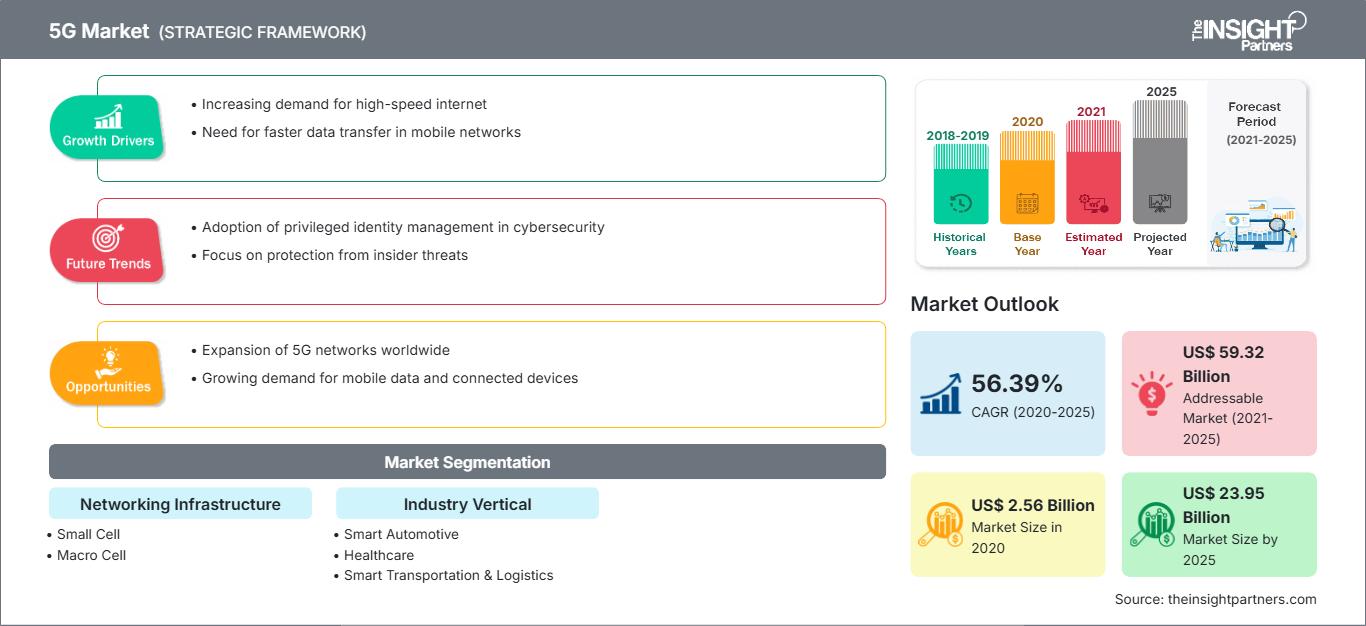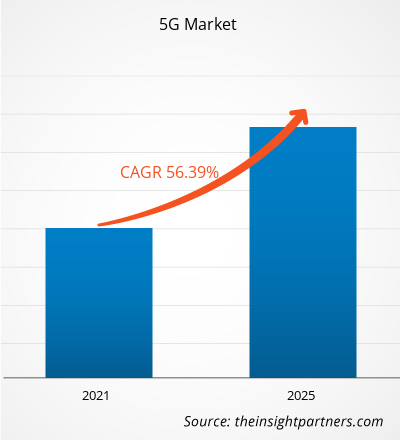Si prevede che il mercato 5G crescerà da 2,56 miliardi di dollari nel 2020 a 23,95 miliardi di dollari entro il 2025, con un CAGR del 56,39% tra il 2020 e il 2025.
Il 5G è utilizzato in tre tipi di servizi connessi: banda larga mobile avanzata, comunicazioni mission-critical e un'enorme Internet of Things. La compatibilità con le future tecnologie è una caratteristica della tecnologia 5G, il che significa che può essere utilizzata con un'ampia gamma di dispositivi, inclusi smartphone, laptop, sistemi di sicurezza e altro ancora. Offre inoltre la flessibilità necessaria per gestire servizi futuri che richiedono velocità Internet più elevate e latenza ultra-bassa. La tecnologia mobile 5G può inaugurare nuove esperienze immersive come la realtà virtuale e la realtà aumentata con velocità di trasmissione dati più elevate e costanti, minore latenza e un costo per bit più basso, oltre a migliorare gli smartphone. Grazie a reti ultra affidabili, accessibili e a bassa latenza, il 5G può abilitare nuovi servizi in grado di rivoluzionare settori come il controllo remoto di infrastrutture chiave, automobili e operazioni mediche. Inoltre, si prevede che saranno richieste velocità di trasmissione dati più elevate con la crescita della domanda di edge computing e della quantità di dati generati dai dispositivi IoT. Pertanto, la crescente penetrazione della tecnologia IoT sta contribuendo alla crescita del mercato 5G.
Si prevede che il mercato globale del 5G registrerà una crescita elevata nel prossimo futuro. Tra i principali fattori trainanti della crescita del mercato figura la crescente necessità di un'infrastruttura di rete per le comunicazioni a basso consumo energetico. Inoltre, si prevede che la crescente domanda di integrazione di rete negli aspetti funzionali dell'infrastruttura per raggiungere l'efficienza di rete guiderà in modo significativo il settore 5G. Secondo Qualcomm, il 5G è stato implementato in oltre 60 paesi in tutto il mondo e continua a crescere. Secondo l'azienda, il tasso di penetrazione e adozione del 5G è molto più rapido rispetto al 4G. La crescente consapevolezza dei vantaggi del 5G sta catalizzando l'adozione della tecnologia, che a sua volta sta dando impulso al mercato 5G. Inoltre, secondo Qualcomm, si prevede che nei prossimi 15 anni verranno investiti 265 miliardi di dollari a livello globale nel settore 5G. Grazie agli ingenti investimenti previsti, si prevede una crescita promettente del mercato.
Potrai personalizzare gratuitamente qualsiasi rapporto, comprese parti di questo rapporto, o analisi a livello di paese, pacchetto dati Excel, oltre a usufruire di grandi offerte e sconti per start-up e università
Mercato 5G: Approfondimenti strategici

-
Ottieni le principali tendenze chiave del mercato di questo rapporto.Questo campione GRATUITO includerà l'analisi dei dati, che vanno dalle tendenze di mercato alle stime e alle previsioni.
Approfondimenti sul mercato 5G
Incoraggiare il sostegno e gli investimenti governativi nelle economie in via di sviluppo in tutto il mondo
Diversi paesi in via di sviluppo stanno puntando sul miglioramento della connettività Internet nazionale. Di conseguenza, gli investimenti nella tecnologia 5G sono in continua crescita, catalizzando il mercato 5G in questi paesi. Ad esempio, il governo dell'Arabia Saudita ha aumentato la sua attenzione sullo sviluppo della tecnologia 5G per raggiungere l'obiettivo VISION 2030 del paese di diventare un'economia leader. Importanti aziende di telecomunicazioni come Ooredoo (Qatar) ed Etisalat Group (Emirati Arabi Uniti) stanno adottando diverse misure per promuovere la tecnologia 5G nei rispettivi paesi. Inoltre, il governo messicano sta lavorando a un progetto chiamato Red Compartida per migliorare la connessione in tutto il paese. L'obiettivo di questo progetto è sviluppare una rete 5G-ready in Messico utilizzando la tecnologia LTE. Inoltre, paesi come Argentina, Cile e Colombia hanno adottato misure per investire nella tecnologia 5G attraverso accordi con importanti aziende di telecomunicazioni come Nokia e Huawei Telecommunications. Pertanto, i fattori sopra menzionati hanno contribuito alla crescita del mercato 5G. Inoltre, secondo il governo indiano, l'India è sul punto di implementare la sua rete 5G. La tecnologia in India è nella sua fase finale di sviluppo e il governo spera di assistere a un tasso di adozione massiccio nei prossimi 5 anni. Ciò stimolerebbe significativamente il mercato 5G nel paese. Cina e Giappone sono tra i paesi chiave nel mercato asiatico 5G, mentre si prevede che l'India emergerà come uno dei paesi più promettenti nel mercato 5G.
Approfondimenti di mercato basati sui settori verticali
La domotica e l'automazione degli edifici sono il settore verticale leader del mercato. Secondo IDC, gli investimenti nella tecnologia delle smart city dovrebbero raggiungere i 135 miliardi di dollari entro il 2021. Si prevede che le tecnologie 5G fungeranno da base per le reti di piccole celle che guideranno la prossima generazione di infrastrutture wireless all'interno di una città intelligente, presentando un'opportunità redditizia per il mercato della tecnologia 5G nel periodo di previsione.
Approfondimenti regionali sul mercato 5G
Le tendenze e i fattori regionali che influenzano il mercato 5G durante il periodo di previsione sono stati ampiamente spiegati dagli analisti di The Insight Partners. Questa sezione analizza anche i segmenti e la geografia del mercato 5G in Nord America, Europa, Asia-Pacifico, Medio Oriente e Africa, America Meridionale e Centrale.
Ambito del rapporto sul mercato 5G
| Attributo del rapporto | Dettagli |
|---|---|
| Dimensioni del mercato in 2020 | US$ 2.56 Billion |
| Dimensioni del mercato per 2025 | US$ 23.95 Billion |
| CAGR globale (2020 - 2025) | 56.39% |
| Dati storici | 2018-2019 |
| Periodo di previsione | 2021-2025 |
| Segmenti coperti |
By Infrastruttura di rete
|
| Regioni e paesi coperti |
Nord America
|
| Leader di mercato e profili aziendali chiave |
|
Densità degli operatori del mercato 5G: comprendere il suo impatto sulle dinamiche aziendali
Il mercato 5G è in rapida crescita, trainato dalla crescente domanda degli utenti finali, dovuta a fattori quali l'evoluzione delle preferenze dei consumatori, i progressi tecnologici e una maggiore consapevolezza dei vantaggi del prodotto. Con l'aumento della domanda, le aziende stanno ampliando la propria offerta, innovando per soddisfare le esigenze dei consumatori e sfruttando le tendenze emergenti, alimentando ulteriormente la crescita del mercato.

- Ottieni il Mercato 5G Panoramica dei principali attori chiave
Gli operatori che operano nel mercato 5G adottano strategie come fusioni, acquisizioni e iniziative di mercato per mantenere le proprie posizioni. Di seguito sono elencati alcuni sviluppi dei principali operatori:
- Nel 2018, AT&T ha firmato un accordo con Crown Castle International Corp. per espandere e semplificare il proprio contratto di locazione continua per l'infrastruttura di rete wireless. Le operazioni di locazione e la gestione sono state modernizzate per migliorare la flessibilità e l'efficienza implementando nuove tecnologie e aumentando la capacità di rete.
- Nel 2018, Cisco ha annunciato la sua collaborazione con Saudi Telecom Company (STC) per lo sviluppo di sistemi e reti di comunicazione 5G in Arabia Saudita. In base a questo accordo, Cisco trasformerà lo sviluppo delle prospettive commerciali delle reti mobili 5G.
- Analisi storica (2 anni), anno base, previsione (7 anni) con CAGR
- Analisi PEST e SWOT
- Valore/volume delle dimensioni del mercato - Globale, Regionale, Nazionale
- Industria e panorama competitivo
- Set di dati Excel
Report recenti
Rapporti correlati
Testimonianze
Motivo dell'acquisto
- Processo decisionale informato
- Comprensione delle dinamiche di mercato
- Analisi competitiva
- Analisi dei clienti
- Previsioni di mercato
- Mitigazione del rischio
- Pianificazione strategica
- Giustificazione degli investimenti
- Identificazione dei mercati emergenti
- Miglioramento delle strategie di marketing
- Aumento dell'efficienza operativa
- Allineamento alle tendenze normative






















 Ottieni un campione gratuito per - Mercato 5G
Ottieni un campione gratuito per - Mercato 5G